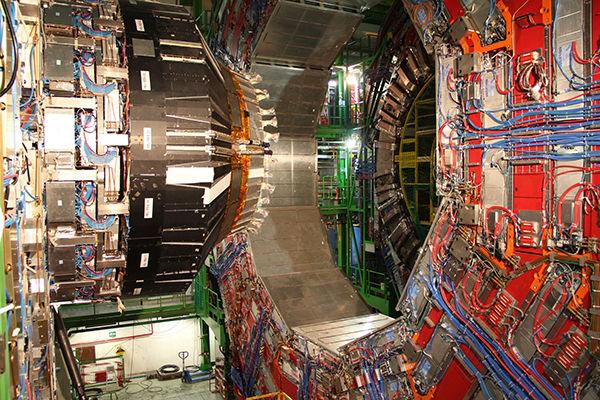The Higgs boson made headlines last year when its discovery was confirmed in Switzerland — an international scientific feat that included work done at Texas A&M.
The particle accelerator that made the discovery possible, Europe’s Large Hadron Collider, has been shut down since February 2013 for upgrades. However, researchers at Texas A&M and the world over are far from taking a break while waiting for the machine to come back online. Thousands of scientists across the world continue to probe the questions raised by the discovery and prepare for a new round of experiments aimed at answering the universe’s most fundamental questions.
Since 2007, members of the physics department at Texas A&M have collaborated on parts of the Large Hadron Collider. Recently, members have worked on constructing new hardware for the LHC’s detectors before the collider comes back online in early 2015.
The Texas A&M group was joined last month by a new faculty member. Keith Ulmer, assistant physics professor, is stationed at the LHC investigating supersymmetry, a new theory that has the potential to explain dark matter.
“In supersymmetry every particle that we know about is theorized to have a partner particle. The partners are a sort of ‘mirror image’ of the original particle,” Ulmer said. “Among other things, supersymmetry is a very exciting possibility because it could provide an explanation of what dark matter is.”
The LHC works by shooting beams of high-energy protons together at velocities close to the speed of light. The energy from the protons and the collision is converted to mass, allowing for the creation of new heavy particles. Six locations along the LHC record the results of these collisions for ongoing experiments. Those working with the LHC analyze the resultant masses in an attempt to glean a deeper understanding of the universe.
“When you’re looking for these particles, you have to keep in mind that these collisions, they might create one of these new particles, but they also create thousands of other particles,” said Texas A&M doctoral student Indara Suarez. “You have to be able to find that one particle between all this other stuff. It’s really the needle in the haystack.”
The LHC includes a massive 27-kilometer ring buried underground between France and Switzerland. The ring consists of superconducting magnets that work to accelerate the particles beams. Over the past year, these magnets have undergone renovations to be able to withstand even higher energies than before.
“The LHC is the largest scientific collaboration ever built,” said physics professor Ricardo Eusebi, who works on the LHC with the rest of the team. “From a sociological aspect, its interesting. But the questions we’re asking are very important. Are there just the particles we know, or are there a set of particles that are absolutely hidden?”
Texas A&M works specifically on an experiment called the Compact Muon Solenoid. Aggie researchers collaborate with more than 4,000 other international researchers to investigate exotic topics such as dark matter, higher dimensions and the Higgs boson.
The CMS is built around a huge magnet that generates magnetic fields 100,000 times stronger than the Earth’s magnetic field. It stands 15 meters high and weighs in at 12,500 tons.
The CMS, which Eusebi said had more metal on it than the Eiffel Tower, stands at the point of collision between the beams of high-energy protons. Researchers are able to analyze what particles do at high energies through the data gathered from the collisions.
“By having very high energies, and seeing what comes out, we can tell how things work,” Eusebi said. “A few years ago, we didn’t know exactly how mass was given to all the fundamental particles. The building bricks of everything in the universe, they have mass. We don’t know why they have the mass they have. They have very random values.”
Eusebi and other team members have spent the past months constructing new hardware that will upgrade the CMS in anticipation of the LHC’s return to experimental operation next year. The A&M team has also spent time analyzing the data taken from the last time the LHC was operational.
Just two years ago researchers were able to use the LHC and data gathered from the CMS to find the Higgs boson, the particle responsible for giving mass to other particles, ending a search that had lasted decades. Eusebi said while the finding of the Higgs boson was a great first step, there are many more questions that need answering.
The CMS team also consists of many students, Suarez said, who were stationed at the LHC for a year and a half to assist the recalibration of the CMS in anticipation of the collider opening for new tests next year.
Eusebi said the unprecedented international collaboration on the LHC, as well as the opportunity to be at the forefront of scientific investigation into the fundamental nature of the universe, excites him about working with the CMS and the other researchers involved.
“At the very end, nature is going to give you an answer,” Eusebi said. “Eventually you are forcing nature to give up her secrets.”
Researchers prep for Large Hadron Collider reopening
October 20, 2014

Provided
Researchers at A&M continue to use data from LHC as it undergoes upgrades.
0
Donate to The Battalion
$2790
$5000
Contributed
Our Goal
Your donation will support the student journalists of Texas A&M University - College Station. Your contribution will allow us to purchase equipment and cover our annual website hosting costs, in addition to paying freelance staffers for their work, travel costs for coverage and more!
More to Discover









